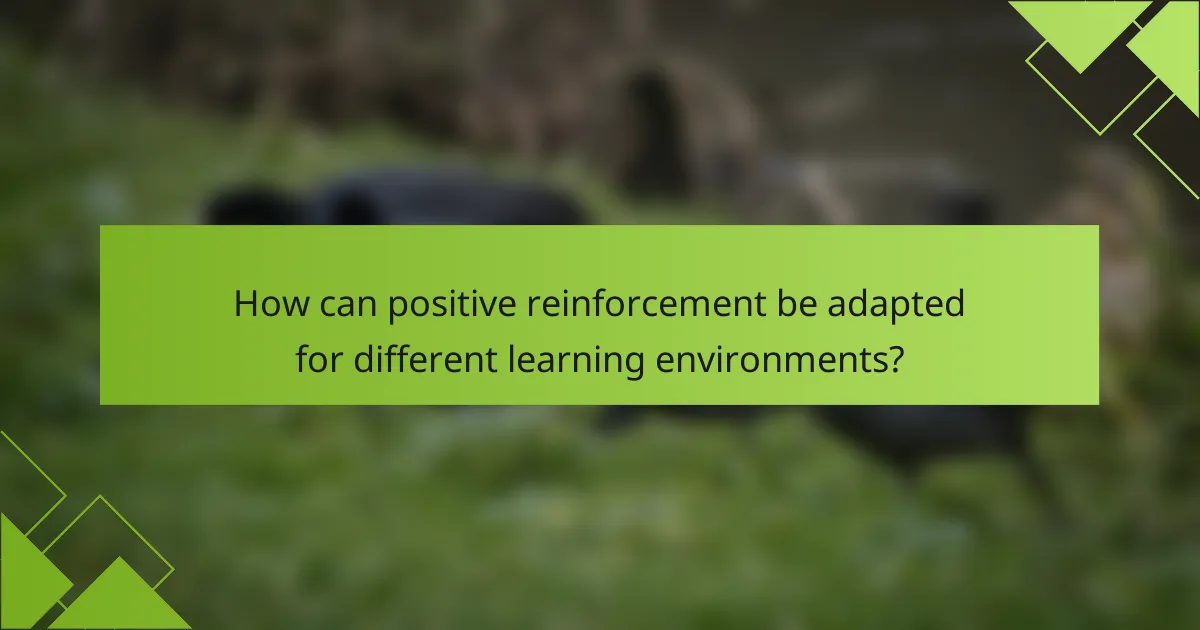Positive reinforcement in dog training enhances obedience and builds trust between dogs and their owners. This article covers effective techniques such as treats, verbal praise, and clicker training. It also addresses common challenges, unique approaches for engagement, and the importance of consistency across different environments. Finally, we explore the long-term benefits of this training method for both dogs and their owners.

What are the key principles of positive reinforcement in dog training?
Positive reinforcement in dog training involves rewarding desired behaviors to encourage their repetition. Key principles include timing rewards immediately after the behavior, using high-value treats or praise, and ensuring consistency in reinforcement. This approach strengthens the bond between the dog and trainer, fosters trust, and enhances learning. Additionally, varying the types of rewards can maintain the dog’s interest and engagement.
How does positive reinforcement differ from traditional training methods?
Positive reinforcement focuses on rewarding desired behaviors, while traditional training often relies on punishment. This approach fosters a positive bond between the dog and trainer, enhancing learning and motivation. In contrast, traditional methods may create fear or anxiety, hindering the training process. Positive reinforcement encourages repeat behaviors through rewards, making it more effective in the long term.
Why is positive reinforcement beneficial for dog behavior?
Positive reinforcement is beneficial for dog behavior as it encourages desired actions through rewards. This technique fosters a positive relationship between dog and owner, enhancing learning and compliance. Dogs trained with positive reinforcement exhibit lower stress levels and improved overall behavior. Studies show that this method increases retention of commands and skills, making training more effective.
Which psychological theories support positive reinforcement techniques?
Psychological theories supporting positive reinforcement techniques include behaviorism, operant conditioning, and social learning theory. Behaviorism emphasizes observable behaviors and their responses to stimuli. Operant conditioning, developed by B.F. Skinner, highlights how rewards increase desired behaviors. Social learning theory, proposed by Albert Bandura, suggests that individuals learn through observation and imitation, reinforcing behaviors when positive outcomes are witnessed. These theories collectively validate the effectiveness of positive reinforcement in dog training.

What are effective positive reinforcement techniques for dog training?
Positive reinforcement techniques for dog training include rewards, praise, and play. These methods encourage desired behaviors through positive outcomes.
1. Treats: Use small, tasty treats to reward good behavior immediately.
2. Verbal praise: Use enthusiastic and positive tones to reinforce actions.
3. Clicker training: Employ a clicker sound to mark desired behavior followed by a reward.
4. Playtime: Engage in fun activities or games as a reward for completing commands.
5. Consistency: Apply the same rewards for specific behaviors to establish clear expectations.
How can treats be used effectively in training sessions?
Treats can enhance training sessions by motivating dogs, reinforcing positive behavior, and creating a fun learning environment. Use high-value treats, like small pieces of meat or cheese, to maintain engagement. Timing is crucial; reward immediately after the desired behavior for clear association. Gradually reduce treat frequency as the dog learns to maintain behavior without constant rewards. Incorporating variety in treats can prevent boredom and sustain interest during training.
What role does praise play in positive reinforcement?
Praise is essential in positive reinforcement as it strengthens desired behaviors in dog training. When a dog receives praise, it associates the behavior with positive outcomes, increasing the likelihood of repetition. This method fosters a trusting bond between the dog and trainer, enhancing learning effectiveness. Consistent and specific praise can significantly improve a dog’s responsiveness and motivation during training sessions.
How can toys and play be incorporated as rewards?
Incorporating toys and play as rewards enhances dog training through positive reinforcement. This method motivates dogs, reinforces good behavior, and strengthens the bond between the dog and trainer.
Toys can serve as effective rewards during training sessions. For example, using a favorite ball can encourage a dog to follow commands. Playtime as a reward can also help improve a dog’s focus and engagement.
Additionally, varying the types of toys keeps the training experience stimulating. Interactive toys, such as puzzle feeders, can provide mental stimulation while rewarding desired behaviors.
In summary, integrating toys and play into training creates a fun, rewarding environment that benefits both the dog and the trainer.
Which timing strategies enhance the effectiveness of positive reinforcement?
Immediate reinforcement enhances the effectiveness of positive reinforcement in dog training. Timing strategies include delivering rewards instantly after desired behaviors, using a clicker to mark behaviors precisely, and maintaining consistent timing to create clear associations. These methods strengthen the learning process, making it easier for dogs to understand which actions are rewarded.

What common challenges arise when using positive reinforcement?
Common challenges in using positive reinforcement in dog training include inconsistency, over-reliance on treats, and misinterpretation of behaviors. Inconsistency can confuse dogs, leading to frustration. Over-reliance on treats may result in weight gain or decreased motivation when treats are unavailable. Misinterpretation occurs when trainers mistakenly reinforce unwanted behaviors, thinking they are rewarding desired actions. Addressing these challenges requires a balanced approach, incorporating various reinforcement methods and clear communication with the dog.
How can inconsistent reinforcement affect training outcomes?
Inconsistent reinforcement can lead to confusion and hinder effective learning in dog training. When rewards are unpredictable, dogs may struggle to understand which behaviors are desirable. This inconsistency can result in anxiety, frustration, and a lack of motivation to engage in training. Positive reinforcement relies on clear, consistent feedback to reinforce desired behaviors effectively. Without this, training outcomes may be compromised, leading to slower progress and potentially reinforcing unwanted behaviors.
What are the signs of over-reliance on treats?
Signs of over-reliance on treats include decreased responsiveness to commands, increased begging behavior, and weight gain. Dogs may also become disinterested in training sessions if treats are the primary motivator. Additionally, reliance on treats can lead to behavioral issues, such as aggression over food. Balancing treat rewards with praise and play can foster better training outcomes and a healthier relationship.
How can distractions be managed during training sessions?
To manage distractions during training sessions, implement structured environments and focused activities. Limit external stimuli by choosing quiet locations and using barriers. Incorporate short, engaging exercises to maintain attention. Use positive reinforcement to redirect focus when distractions occur.

What unique approaches can enhance positive reinforcement training?
Utilizing unique approaches can significantly enhance positive reinforcement training for dogs. Incorporating play-based learning techniques can increase engagement and motivation.
Another effective method is to use variable reinforcement schedules. This approach keeps dogs guessing, which can strengthen their learning and retention.
Incorporating sensory enrichment, such as different textures or scents during training, can also help maintain a dog’s interest and focus.
Lastly, integrating social reinforcement, like praise or playtime with other dogs, can further motivate positive behavior and reinforce learning outcomes.
How does clicker training fit into positive reinforcement strategies?
Clicker training is a key component of positive reinforcement strategies in dog training. It utilizes a distinct sound to mark desired behaviors, creating a clear communication channel between the trainer and the dog. This method enhances learning by providing immediate feedback, which is crucial for effective reinforcement.
The clicker serves as a consistent signal, helping dogs associate the sound with positive outcomes like treats or praise. This strengthens the bond between the dog and trainer, fostering trust and motivation. Clicker training can be applied to various commands and behaviors, making it a versatile tool in positive reinforcement techniques.
Additionally, it encourages a proactive learning environment. Dogs are motivated to repeat behaviors that earn them clicks, leading to faster and more reliable learning. This approach aligns with the core principles of positive reinforcement, emphasizing reward over punishment.
Which training methods are specific to certain breeds or temperaments?
Certain dog breeds and temperaments benefit from specific training methods tailored to their unique characteristics. For example, herding breeds like Border Collies thrive with agility training due to their high energy and intelligence. Conversely, more timid breeds like Shih Tzus may respond better to gentle, positive reinforcement techniques that build confidence.
Terriers, known for their stubbornness, often require consistent and firm training methods to maintain focus. In contrast, retrievers typically excel with reward-based training, as they are eager to please. Additionally, social breeds such as Golden Retrievers benefit from group training sessions that enhance their sociability.
Understanding these breed-specific traits allows trainers to customize approaches, ensuring effective learning and a positive experience for both the dog and owner.
What innovative tools or technology can support positive reinforcement?
Innovative tools and technology that support positive reinforcement in dog training include clickers, treat-dispensing toys, and mobile apps. Clickers provide precise timing for rewards, enhancing communication. Treat-dispensing toys keep dogs engaged while encouraging desired behaviors. Mobile apps track training progress and offer reminders for reinforcement schedules. These tools leverage technology to create effective training environments that foster learning through positive reinforcement.

How can positive reinforcement be adapted for different learning environments?
Positive reinforcement can be effectively adapted for various learning environments by tailoring techniques to suit specific contexts. For instance, in a home setting, using treats or praise can motivate dogs to learn commands. In a group class, social rewards like playtime with other dogs can enhance engagement.
Different environments may require unique reinforcement strategies. In a veterinary clinic, calming rewards can help dogs associate visits with positive experiences. In outdoor training, using environmental stimuli as rewards can maintain a dog’s focus.
Consistency is crucial across all settings. Reinforcement should be immediate to establish a clear connection between behavior and reward. Adjusting the intensity and type of reinforcement based on the dog’s response can optimize learning outcomes.
Monitoring progress and adapting strategies based on individual dog behavior ensures that positive reinforcement remains effective in diverse learning environments.
What strategies work best for training in public spaces?
Positive reinforcement techniques work best for training dogs in public spaces. These strategies enhance focus and compliance amidst distractions.
1. Use high-value treats to motivate your dog during training sessions.
2. Implement clicker training to mark desired behaviors instantly.
3. Practice basic commands like “sit” and “stay” in various environments to build reliability.
4. Gradually increase distractions while rewarding your dog for maintaining focus.
5. Incorporate play as a reward to reinforce positive behaviors in a fun way.
How can positive reinforcement be utilized in group training settings?
Positive reinforcement can enhance group training by encouraging desired behaviors through rewards. This approach fosters a positive atmosphere, increasing engagement and motivation among participants.
Utilizing techniques like treats, praise, or playtime effectively reinforces good behavior. For example, rewarding a dog for following commands promotes learning and strengthens the bond between the trainer and the dog.
In group settings, consistency in applying positive reinforcement is crucial. It ensures all participants understand expectations and reinforces a collaborative environment. This method can lead to significant improvements in group dynamics and overall training success.
Additionally, tracking progress and celebrating milestones can further motivate participants. Recognizing achievements, no matter how small, builds confidence and encourages ongoing participation.
Which adjustments are necessary for training rescue or anxious dogs?
Adjustments for training rescue or anxious dogs include creating a safe environment, using positive reinforcement, and building trust gradually. Consistency in commands and routines helps reduce anxiety. Incorporate breaks and avoid overwhelming stimuli. Gradually introduce new experiences to foster confidence.

What are the long-term benefits of positive reinforcement training?
Positive reinforcement training offers long-term benefits such as improved behavior, stronger bonds, and increased confidence in dogs. This method encourages desirable actions through rewards, leading to lasting behavioral changes.
1. Enhanced obedience: Dogs trained with positive reinforcement tend to follow commands reliably over time.
2. Reduced anxiety: This approach fosters a safe learning environment, minimizing stress-related behaviors.
3. Increased motivation: Dogs become eager to learn and engage, enhancing their overall training experience.
4. Strengthened human-animal bond: Positive interactions during training deepen trust and affection between the dog and owner.
5. Lifelong learning: Dogs trained with this technique are more open to learning new skills throughout their lives.
How does positive reinforcement impact the dog-owner relationship?
Positive reinforcement strengthens the dog-owner relationship by fostering trust and communication. This technique encourages desired behaviors through rewards, leading to a more positive interaction. As a result, owners experience improved obedience and companionship from their dogs. Consistent use of positive reinforcement also enhances the dog’s confidence, creating a bond based on mutual respect and understanding.
What improvements in behavior can be expected over time?
Improvements in behavior from positive reinforcement dog training techniques can be significant over time. Consistent application leads to better obedience, reduced anxiety, and enhanced bonding with the owner. As dogs associate commands with rewards, their responsiveness increases. This training fosters a positive learning environment, resulting in long-lasting behavioral changes. Regular practice and reinforcement can yield noticeable results within weeks, while deeper behavioral transformations may take several months.
How does positive reinforcement contribute to a dog’s mental well-being?
Positive reinforcement significantly enhances a dog’s mental well-being by fostering trust and reducing anxiety. This training method encourages desirable behaviors through rewards, promoting a positive emotional state. Dogs trained with positive reinforcement exhibit increased confidence and improved social interactions. Research indicates that these techniques lead to lower stress levels, enhancing overall mental health.

What expert tips can enhance the effectiveness of positive reinforcement?
To enhance the effectiveness of positive reinforcement in dog training, focus on consistency, timing, and rewards. Consistent cues help dogs understand what behaviors are desired. Immediate rewards reinforce the connection between the behavior and the positive outcome, making learning more effective. Use a variety of rewards, such as treats, praise, or play, to keep the dog engaged. Tailor the reinforcement to the individual dog’s preferences for maximum impact.
How can trainers maintain consistency in their methods?
Trainers can maintain consistency in their methods by establishing clear guidelines and routines. Consistent reinforcement of positive behaviors helps dogs learn effectively. Regular training sessions, standardized commands, and uniform reward systems are essential. Additionally, trainers should regularly assess their techniques and adapt as needed to ensure alignment with positive reinforcement principles.
What are the best practices for transitioning from treats to other rewards?
Transitioning from treats to other rewards in dog training can enhance motivation and engagement. Start by gradually reducing treat frequency while introducing verbal praise, playtime, or toys as alternatives.
1. Identify effective non-food rewards, such as toys or activities your dog enjoys.
2. Use a combination of rewards to maintain interest and excitement during training.
3. Monitor your dog’s response to different rewards to find the most effective options.
4. Reinforce positive behavior consistently, ensuring your dog understands the connection between actions and rewards.
This approach fosters a balanced training environment, promoting long-term behavioral change.
What common mistakes should be avoided in positive reinforcement training?
Avoiding common mistakes in positive reinforcement training enhances effectiveness. Key mistakes include inconsistency in rewards, using the wrong type of reward, failing to reinforce immediately, and neglecting to consider the dog’s emotional state. Consistency ensures dogs understand what behaviors are rewarded. Choosing appropriate rewards, such as treats or praise, is crucial for motivation. Immediate reinforcement helps dogs connect the action with the reward. Lastly, being mindful of the dog’s mood can prevent negative associations with training.
